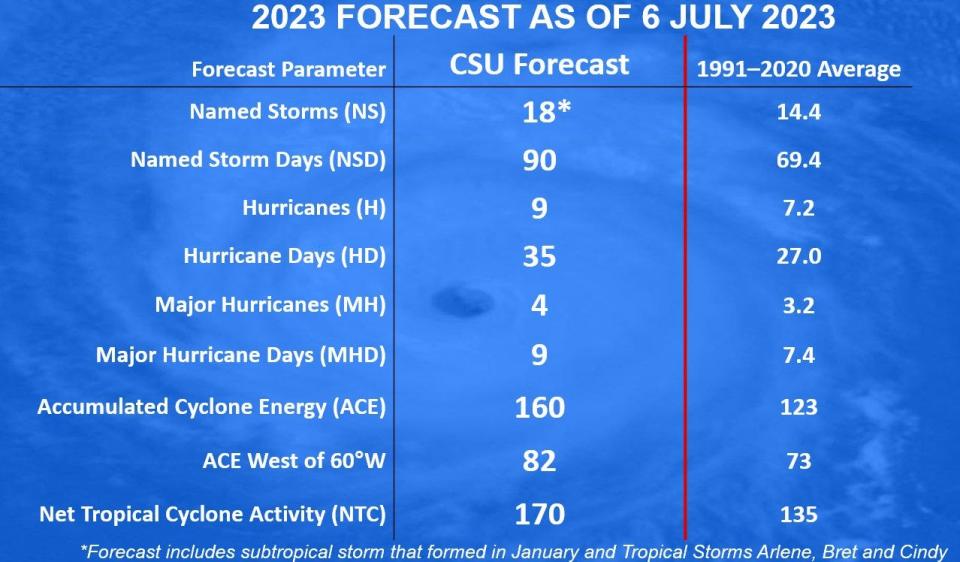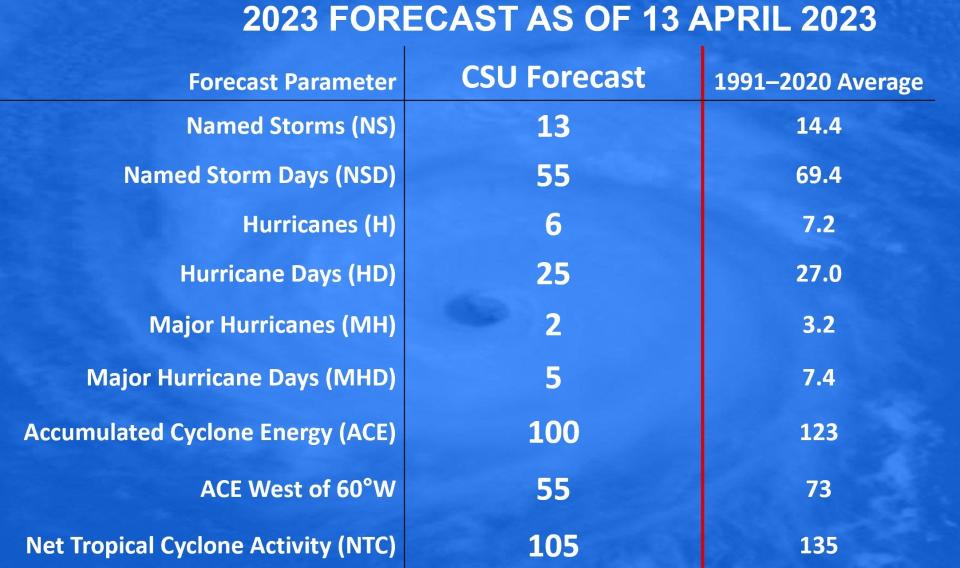Latest prediction calls for 'above-normal' hurricane season. See what that means for Florida
Colorado State University has updated its 2023 hurricane season forecast and is now predicting an "above-normal" season.
The July forecast differs sharply from forecasters' earlier prediction in April, which predicted a slightly below-normal season.
What lead to the sharp increase in the number of predicted storms?
Atlantic quiet, for now: Atlantic hurricane activity quiet as NHC, NOAA watch tropical waves, hot oceans.
Earth's hottest day? July 4 set a record, scientists say
While a robust El Niño is still in the forecast during the peak of the Atlantic hurricane, record warm water temperatures are expected to offset El Niño's effect and lead to the formation of more storms, according to the CSU report.
"The continued anomalous warming of the tropical and subtropical Atlantic is the primary reason for the increase in our forecast numbers with this update," according to the CSU report.
Forecasters are warning "uncertainty with this outlook is larger than normal."
Hurricane activity in the Atlantic basin — which consists of the Atlantic Ocean north of the equator, Caribbean Sea and Gulf of Mexico — has been quiet since Tropical Storms Bret and Cindy in late June.
Forecasters say the calm won't last, especially with the extremely warm ocean temperatures out there. Warm water provides the energy for tropical storms to develop and strengthen into major hurricanes.
Bottom line: Coastal residents were reminded it only takes one hurricane making landfall tomake it an active season for them, CSU said. Residents should prepare the same for every season,regardless of how much activity is predicted.
CSU calling for 18 named storms, 4 major hurricanes

The July CSU forecast for the remainder of the Atlantic hurricane season calls for 18 named storms, including the four that have already formed.
Nine are predicted to become hurricanes and four are forecast to become major hurricanes. A major hurricane is one that reaches at least Category 3 strength, with maximum sustained winds of 111 mph or higher.
What are the chances of major hurricane hitting US?
The probability of a major hurricane hitting the following coastal areas is:
Entire continental U.S. coastline: 50% (full-season average from 1880–2020 is 43%).
U.S. East Coast, including Florida south and east of Cedar Key: 25% (full-season average from 1880–2020 is 21%).
Gulf Coast from the Florida Panhandle west and north of Cedar Key, Florida: westward to Brownsville - 32% (full-season average from 1880–2020 is 27%).
CSU April forecast called for slightly below-normal hurricane season

Forecasters with Colorado State University in April predicted a slightly below-normal Atlantic hurricane season this year.
The early prediction for the season called for 13 named storms, slightly below the average of 14.4 storms.
Six hurricanes are forecast, with two becoming major hurricanes. Those figures also fall below the average of 7.2 hurricanes and 3.2 major hurricanes.
April CSU prediction: CSU predicting 13 named storms, 2 major hurricanes this season
Why did forecasters originally predict below-normal hurricane season?
While water temperatures in the tropics are much warmer than usual — which helps the development of tropical systems — El Niño inhibits their growth. And all indications are that 2023 will be an El Niño year beginning in the summer and extending into the fall.
The peak of the hurricane season hits Sept. 10, with the busiest months typically being August through October.
What impact does El Niño have on the development of hurricanes?
El Niño brings wind shear across the Atlantic basin, which limits tropical cyclone development and intensification.
NOAA and other forecasters factor in El Niño when they make their seasonal hurricane predictions.
Impact of El Niño on hurricanes: El Niño is back, NOAA says. Will it help fuel Earth's hottest year on record?
When is Atlantic hurricane season and when are hurricanes most likely to form?

The Atlantic hurricane season runs from June 1 through Nov. 30, with the busiest months August through October. The peak of the season is Sept. 10.
This article originally appeared on Fort Myers News-Press: CSU Atlantic hurricane season forecast: 18 storms, 4 major hurricanes

